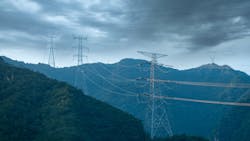Bulk Power System Remains Highly Reliable, NERC Report Highlights Key Challenges
In 2020, the North American bulk power system faced numerous challenges, including extreme weather, cyber and physical threats and a rapidly changing generation resource mix, all within the context of a global pandemic. NERC’s 2021 State of Reliability, which looks at past performance, found that the grid continued to perform well, while highlighting key concerns for managing an evolving system, including energy adequacy, sensitivities to weather events and a surge in cyber security attacks.
“Key indicators show that mitigation efforts put in place for critical risks are effectively being addressed,” said John Moura, NERC’s director of Reliability Assessment and Performance Analysis. “However, the unprecedented stressors in 2020 challenged the system and showed us where the weak links are. It’s clear that the resource and energy adequacy, as well as the increasing exposure to extreme weather conditions, is a priority issue for the industry.”
The report highlights the health of the interconnected system and the effectiveness of reliability risk mitigation activities. Outages due to human error and equipment failure continued to decline, demonstrating the success of mitigation activities focused on human performance and system maintenance. At the same time, weather events and wildfires caused more transmission outages than in previous years, highlighting the importance of continued preparedness and grid resilience. Other key findings include:
- The bulk power system remained stable in 2020; however, there was an increase in operator-initiated load shedding — a last-resort option to maintain grid stability.
- The transforming fuel mix requires more supplemental and flexible resources to balance supply and demand. More transmission is needed to access these diverse resources.
- Load shed during the summer months shows the growing vulnerability to extreme weather and highlights the energy adequacy risks.
- Supply chain risks increase the threat landscape and underscore the urgency of cyber risk response.
- Advanced planning allowed pandemic impacts to be avoided.
“This year’s report underscores the value of coordination with ERO Enterprise stakeholders, government partners, industry, trade associations and other industry groups; advanced planning; and the importance of the information NERC collects to evaluate the performance of the bulk power system under extreme climate conditions, grid transformation and challenges to cyber and physical security,” said Donna Pratt, NERC’s performance analysis manager.
The report’s high-level recommendations, to inform regulators, policymakers and industry leaders, include:
- The ERO and industry should continue improving their ability to model, plan, and operate a system with a significantly different resource mix.
- System planners should evaluate the need for flexibility as conventional generation retirements are considered by industry and policymakers. Retirement planning studies should consider interconnection-level impacts and sensitivity assessments associated with the loss of critical transmission paths and the loss of local generation in larger load pockets.
- The ERO and industry should develop comparative measurements and metrics to understand the different dimensions of resilience during the most extreme events and how system performance varies with changing conditions.
- The ERO, industry and government should significantly increase the speed and detail of cyber and physical security threat information sharing in order to counter the increasingly complex and targeted attacks by capable nation-state adversaries and criminals on critical infrastructure. This should be complemented by a review of cyber security standards, supply chain procurement, risk assessment as well as a review of the CIP standard’s bright-line criteria between high-, medium-, or low-impact assets.
The 2021 State of Reliability focuses on four key risk areas that were identified by the Reliability Issues Steering Committee (RISC) in its 2019 Risk Priorities Report: grid transformation, extreme natural events, security risks and critical infrastructure interdependencies. The RISC, which functions as an advisory committee to NERC’s Board of Trustees, recently released its 2021 ERO Reliability Risk Priorities Report. The report provides a forward-looking view of imminent and projected risks to bulk power system and helps inform activities and analysis.
